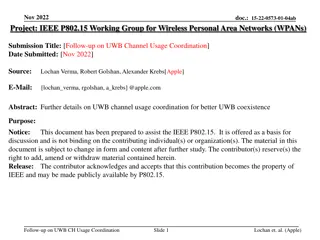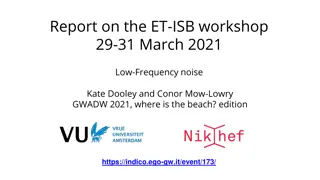Further Considerations on Frequency Stitching and CIR Reports in UWB Next Generation
This document addresses enhancements in frequency stitching and CIR reports for the IEEE P802.15 Working Group, focusing on UWB technology. It discusses safeguards, interference mitigation, coexistence improvements, and proposed solutions to support high data throughput while avoiding disruption to low-duty-cycle use cases. Various aspects of system operation and performance improvements are detailed, including additional channels, improved accuracy and reliability, reduced complexity, and power consumption. The document also covers sensing capabilities, CIR reporting, peer-to-peer communication support, and infrastructure synchronization mechanisms.
Download Presentation

Please find below an Image/Link to download the presentation.
The content on the website is provided AS IS for your information and personal use only. It may not be sold, licensed, or shared on other websites without obtaining consent from the author.If you encounter any issues during the download, it is possible that the publisher has removed the file from their server.
You are allowed to download the files provided on this website for personal or commercial use, subject to the condition that they are used lawfully. All files are the property of their respective owners.
The content on the website is provided AS IS for your information and personal use only. It may not be sold, licensed, or shared on other websites without obtaining consent from the author.
E N D
Presentation Transcript
doc. IEEE 15-23-0461-00-04ab Project: IEEE P802.15 Working Group for Wireless Specialty Networks (WSN) Submission Title: Further considerations on frequency stitching and CIR reports Source: Bin Qian, Chenchen Liu, Lei Huang, Xiaohui Peng, David Xun Yang (Huawei Technologies) Address : [Huawei Bantian Base, Longgang District, Shenzhen, 518129 China] E-Mail: [qianbin14@huawei.com] Re: Task Group 4ab: UWB Next Generation for 802.15.4 Abstract: [UWB, frequency stitching, CIR reports] Purpose: Notice: This document has been prepared to assist the IEEE P802.15. It is offered as a basis for discussion and is not binding on the contributing individual(s) or organization(s). The material in this document is subject to change in form and content after further study. The contributor(s) reserve(s) the right to add, amend or withdraw material contained herein. Release: The contributor acknowledges and accepts that this contribution becomes the property of IEEE and may be made publicly available by P802.15. Submission
Slide 2 doc. IEEE 15-23-0461-00-04ab PAR Objective Safeguards so that the high throughput data use cases will not cause significant disruption to low duty-cycle ranging use cases Interference mitigation techniques to support higher density and higher traffic use cases Other coexistence improvement Backward compatibility with enhanced ranging capable devices (ERDEVs) Improved link budget and/or reduced air-time Proposed Solution (how addressed) Additional channels and operating frequencies Improvements to accuracy / precision / reliability and interoperability for high-integrity ranging Reduced complexity and power consumption Hybrid operation with narrowband signaling to assist UWB Enhanced native discovery and connection setup mechanisms (1) Frequency stitching parameters and channel order mapping Sensing capabilities to support presence detection and environment mapping (2) CIR reports with multiple segments Low-power low-latency streaming Higher data-rate streaming allowing at least 50 Mbit/s of throughput Support for peer-to-peer, peer-to-multi-peer, and station-to- infrastructure protocols Infrastructure synchronization mechanisms Submission
Sep. 2023 doc. IEEE 15-23-0461-00-04ab Reference [1] IEEE 802.15/23-284r1, "Latest Consensus on UWB Sensing PHY and MAC" [2] IEEE 802.15/22-538r7, Proposal of sensing framework" [3] IEEE 802.15/23-178r0, Frequency stitching considerations" [4] IEEE 802.15/23-332r0, Considerations on channel order in frequency stitching" Submission Slide 3 Bin Qian, Huawei
Sep. 2023 doc. IEEE 15-23-0461-00-04ab Background In [1-2], the frequency stitching parameters are discussed as below Bits: 0 1-4 5-6 7 8-11 12-13 14-15 Frequency Stitching Direction Carrier Frequency Grid Channel Sequence Order Number of Transmissions Feedback Control Base Channel Reserved Frequency Stitching Direction field indicates the center frequency change direction of subsequent channels based on the base channel. When 1, the base channel has the lowest center frequency, when 0, the base channel has the highest center frequency Base Channel field indicates the starting channel Carrier Frequency Grid is equal to the overlap factor (OF) 0, no overlap; 1, 25% overlap; 2, 50% overlap; 3, 75% overlap Channel Sequence Order field specifies the sequence of channel use 0, in-sequence channel order; 1, out-of-sequence channel order Submission Slide 4 Bin Qian, Huawei
Sep. 2023 doc. IEEE 15-23-0461-00-04ab Channel Sequence Order When the out-of-sequence channel order is applied, the channel order are computed according to CH((p*(OF+1) MOD (N)) + (p*(OF +1) DIV (N))) p starts sequentially from 0 to N-1 Let M denote the total number of transmissions. If M is divisible by (OF + 1), N equals to M Otherwise, N is the smallest integer greater than M and divisible by (OF + 1). In this case, CH(0), CH(1), , CH(N-1) is padded with unused channels, which corresponds to idle transmitter OF is the overlap factor MOD is the modulo operator, and DIV denotes integer division Submission Slide 5 Bin Qian, Huawei
Sep. 2023 doc. IEEE 15-23-0461-00-04ab Channel Sequence Order (cont.) Example: suppose there are 8 channel bands for frequency stitching and the Channel Sequence Order field value is 1, the channel use sequence is as follows OF Channel Use Sequence CH(0), CH(3), CH(6), CH(1), CH(4), CH(7), CH(2), CH(5) 2 CH(0), CH(4), CH(1), CH(5), CH(2), CH(6), CH(3), CH(7) 3 Note that when OF is 0 or 1, the in-sequence channel order shall be applied [1, 4] Obviously, the calculated channel use sequence cannot match the center frequency of the extended UWB channel for frequency stitching Proposal 1: The center frequency ?? (in MHz) of CH(i) could be computed according to ??= ?????+ 124.8 ? 4 ?? 2 ? 1 ????? is the center frequency of the base channel ? is the Frequency Stitching Direction field value Submission Slide 6 Bin Qian, Huawei
Sep. 2023 doc. IEEE 15-23-0461-00-04ab Channel Sequence Order (cont.) Example There are 8 channel bands for frequency stitching The Channel Sequence Order field value is 1 The center frequency of the base channel is 7987.2 MHz Center frequency (in MHz) of channel used when the Frequency Stitching Direction field value is 1 Center frequency (in MHz) of channel used when the Frequency Stitching Direction field value is 0 OF Channel Use Sequence CH(0), CH(3), CH(6), CH(1), CH(4), CH(7), CH(2), CH(5) 7987.2, 8736.0, 9484.8, 8236.8, 8.9856, 9734.4, 8486.4, 9235.2 7987.2, 7238.4, 6489.6, 7737.6, 6988.8, 6240.0, 7488.0, 6739.2 2 CH(0), CH(4), CH(1), CH(5), CH(2), CH(6), CH(3), CH(7) 7987.2, 8361.6, 8736.0, 8112.0, 8486.4, 8860.8, 8236.8, 8611.2 7987.2, 7612.8, 7238.4, 7862.4, 7488.0, 7113.6, 7737.6, 7363.2 3 Submission Slide 7 Bin Qian, Huawei
Sep. 2023 doc. IEEE 15-23-0461-00-04ab Intra-packet and Inter-packet Frequency Stitching Three types of frequency stitching Intra-packet: Across segments in the SENS field Inter-packet: Across multiple packets The combination of intra-packet and inter-packet Proposal 2: Add Frequency Stitching Type field to the frequency stitching parameters Occupy 2 bits 0, Intra-packet; 1, Inter-packet; 2, Combination of intra-packet and inter-packet; 3, Reserved Submission Slide 8 Bin Qian, Huawei
Sep. 2023 doc. IEEE 15-23-0461-00-04ab CIR Report IE Octets: 4/8/16/32 Bits: 0-1 2-3 4-13 14-15 Variable Number of Segments Receive Report(s) Antennas Bitmap Length Bitmap Offset CIR Bitmap The Receive Report(s) field is per segment per Rx chain Proposal 3: Add Number of Segments field to the CIR Report IE to make it self- contained. The number of receive reports in the Receive Report(s) field is equal to the number of receiver chain times the number of segments Proposal 4: Multiple receive reports shall be arranged in a certain way, e.g., in the sequence of antenna ID first and the segment index second Example: there are two Rx antennas and two segments, the Receive Report(s) field is formatted below Receive Report for Antenna 1 and Segment 1 Receive Report for Antenna 1 and Segment 2 Receive Report for Antenna 2 and Segment 1 Receive Report for Antenna 2 and Segment 2 Submission Slide 9 Bin Qian, Huawei
Sep. 2023 doc. IEEE 15-23-0461-00-04ab Summary It is suggested to associate the center frequency of the extended UWB channel with the out-of-sequence channel order calculation formula It is suggested to add Frequency Stitching Type field to the frequency stitching parameters It is suggested to add Number of Segments field to the CIR Report IE It is suggested to arrange the multiple receive reports included in the Receive Report(s) field in a certain way Submission Slide 10 Bin Qian, Huawei
Sep. 2023 doc. IEEE 15-23-0461-00-04ab Thank You Submission Slide 11 Bin Qian, Huawei























